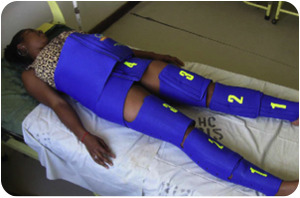
Problem being addressed[edit | edit source]
Obstetrical hemorrhage is heavy bleeding of a woman during or right after pregnancy. Many women die from hemorrhaging because they are not within close reach of a hospital and are in resource limited clinic settings.
Detailed description of the solution[edit | edit source]
The Non-Pneumatic Anti-Shock Garment (NASG), delivers circumferential counter pressure to the lower body, legs, pelvis, and abdomen. The counter pressure decreased the contained size, reduced blood flow in compressed area, while the blood to the uncompressed area (core organs) is enhanced. The pressure applied by NASG does not exceed 70 mmHg, hence avoiding potential ischemia or compartment syndrome. Compression decreases the radius of the blood vessels in the abdomen and pelvis, including the splanchnic plexus, which decreases blood flow. It is made of neoprene and Velcro ™, with a foam compression ball that is placed over the abdomen.
The name LifeWrap™ was given to this medical device by UCSF which has pioneered the clinical trials of this device as an obstetric first aid solution for low-resource settings.
Designed by[edit | edit source]
- Designed by: Dr. Carol Brees and Dr. Paul Ansleigh
- Manufacturer: now the NASG is off patent and is being manufactured in China and India
- Manufacturer (if different): LifeWrap, Inc., Zoex Corporation
- Manufacturer location: Hong Kong & Ashland, OR
- Key Distributors: VIA Global Health - NASG Product Page or main site https://www.viaglobalhealth.com, Maternova, Inc. http://maternova.net, also available in India through NASG-India
When and where it was tested/implemented[edit | edit source]
Clinical trials were undertaken in Pakistan, as well as Nigeria and Egypt. The device is also being implemented in Tanzania, the Philippines and multiple other settings.
Funding Source[edit | edit source]
References[edit | edit source]
Peer-reviewed publication[edit | edit source]
Other internally generated reports[edit | edit source]
Externally generated reports[edit | edit source]
Hauswald, M., et al., Use of an improvised pneumatic anti-shock garment and a non-pneumatic anti-shock garment to control pelvic blood flow. International Journal of Emergency Medicine, 2010. 3(3): p. 173-175. Hensleigh PA. Anti-shock garment provides resuscitation and haemostasis for obstetric haemorrhage. BJOG. 2002 Dec;109(12):1377-84. Miller, S., et al., Obstetric hemorrhage and shock management: Using the low technology Non-pneumatic Anti-Shock Garment in Nigerian and Egyptian tertiary care facilities. BMC Pregnancy and Childbirth, 2010. 10. Ojengbede, O.A., et al., Assessing the role of the non-pneumatic anti-shock garment in reducing mortality from postpartum hemorrhage in Nigeria. Gynecologic and Obstetric Investigation, 2011. 71(1): p. 66-72.
IP and copyright[edit | edit source]
The device is off patent and is being produced under careful international standards in India and Asia.